by Wallace Wyss –
To understand the impact of the Jaguar E-type (XKE in the US) you have to remember the bloated cars Detroit was making in 1961. The E-type was downright revolutionary, sort of like when the American P51 pilots came head to head with Russian MIGs over Korea. I clearly remember changing classes one day in Junior High, clutching the new Road & Track, which had a full page ad for the new E-type on the back cover, and, recognizing a fellow enthusiast–Michael McDaid–and passing it to him, like passing the torch in the Olympics.
I think it was promising something like 160 mph. It was 14 years in production from 1961 to 1975. It sold well, and at least their major redesign was only the rear, with some feeling the redesign was better. Near the end, it got an optional big upgrade to twice the number of cylinders, as many as egad, Ferrari!
Besides the aerodynamic body shaped to the dictates of Malcolm Sayer, an aerodynamist, the claim was a 150 mph (241 km/h) top speed, with the 0 to 60 mph (97 km/h) time under 7 seconds. It had unitized construction, disc brakes all round, rack-and-pinion steering, and independent front and rear suspension. The Corvette wouldn’t get independent rear suspension until 1963.
Jaguar says the E-type is based on Jaguar’s D-Type racing car, which had won the 24 Hours of Le Mans for three consecutive years beginning in 1955. They claimed it was based on the idea of having a central tub and having a front subframe carry the engine, front suspension and front bodywork. No ladder frame was necessary and this paid off in the relatively light weight of 1315 kg (2900 lb) for the steel bodied car.
The car got a lot of publicity on looks alone and was soon featured in half a dozen TV series and movies, right up through movies made decades years later, anything portraying the swingin’ London of the 1960s such as the Austin Powers films.
There were two body styles at first, both two seaters–the fixed head coupe and the open roadster. A “2+2” four-seater version of the coupé, with a lengthened wheelbase, was released in 1966. That had an ungainly roof style but would seat two children in the back. There were so many small changes it is difficult for a newcomer to separate a Series I from Series 2. This crucially important when you consider the first of any given series is usually worth more than the series that followed.
HOW TO SPOT A SERIES I
If the E-type in front of you is built between 1961 and 1964, has a 3.8-liter engine and partial synchromeshed transmission it is a Series I. If it was made between 1965–1967, and boasts a 4.2 liter engine and a fully synchronized transmission it is a Series 2. Other updates for a Series 2 are reclining seats, an alternator in place of the generator, an electrical system switched to negative earth, and a more reliable brake servo.
By the way in terms of comfort, the early Series I’s were flat floor models so that made it difficult for 6 foot and over people. Yet ironically because that confirms it is an early car, some restored ones are worth $500,000. There were also a few factory lightweights made just for racing. It was this car that spurred Enzo Ferrari to make the 250GTO. Only twelve were built, one selling for $7,370,000 at 2017 Scottsdale, Arizona auction.
Some feel all Series I cars had the bubble headlamp covers but in fact some were sold without them. One figure is that a total of 7,828 3.8-litre Series 1 roadsters were built, with 6,749 of the later 4.2-liter Series 1 roadsters. The 1968 Series 1.5 cars retained the design but due to US emissions laws the triple SU carburetors were replaced with twin Zenith-Stromberg units, with a subsequent drop in horsepower from 265 to 246.
The 4.2-liter engine produced the same power as the 3.8-liter (265 bhp;198 kW) and same top speed (150 mph;241 km/h), but increased torque approximately 10% from 240 to 283 lb⋅ft (325 to 384 N⋅m). The 0 to 60 mph times were around 6.4 seconds for both engines. The 4.2-liter’s block had been redesigned, made longer to accommodate 5 mm (0.20 in) larger bores, and the crankshaft modified for new bearings. Other engine upgrades included a new alternator/generator and an electric cooling fan.
Autocar road tested a UK spec E-Type 4.2 fixed head coupé in May 1965. The maximum speed they recorded was 153 mph (246 km/h), the 0–60 mph (0–97 km/h) time was 7.6 seconds and the 1⁄4 mile (402 m) from a standing start took 15.1 seconds. They summarized: “In its 4.2 guise the E-Type is a fast car (the fastest we have ever tested) and offers just about the easiest way to travel quickly by road.”
Motor magazine road tested a UK spec E-Type 4.2 fixed head coupé in Oct 1964. The maximum speed was 150 mph (241 km/h), the 0-60 mph (97 km/h) time was 7 seconds and the 1⁄4 mile (402 m) time was 14.9 seconds. They summarized it as “The new 4.2 supersedes the early 3.8 as the fastest car Motor has tested. The absurd ease which 100 mph (161 km/h) can be exceeded in a 1⁄4 mile (402 m) never failed to astonish. 3,000 miles (4,828 km) of testing confirms that this is still one of the worlds outstanding cars”.
SPOILER ALERT At least one British magazine admitted Jag especially massaged their test car by engine balancing and gas-flow checking the cylinder heads on their test car before they got it, but in the car magazine world the automakers always be tryin’ to gild the lily, right? (Speaking as an ex-Motor Trender…)
All E-Types featured independent coil spring rear suspension designed by developed by R J Knight with torsion bar front ends, and four wheel disc brakes, in-board at the rear, all were power-assisted. Four-wheel disc brakes were also used, and Jaguar was not alone in this, in that era by Austin-Healey, MG, and the French Citroën DS which was pretty progressive. Jaguar had them as standard going back to the XK150 in 1958. The Series 1 (except for late 1967 models) can be recognized by glass-covered headlights (up to 1967), small “mouth” opening at the front, signal lights and tail-lights above bumpers and exhaust tips under the number plate in the rear.
The 3.8 cars have leather bucket seats, an aluminium-trimmed centered instrument panel and console (changed to vinyl and leather in 1963), and the dreaded a Moss four-speed gearbox that lacks synchromesh in first. The 4.2-liter cars have more comfortable seats, improved brakes and electrical systems, and finally an all-synchromesh Jaguar-designed four-speed manual.
Optional extras included chrome spoked rims and a detachable hard top for the roadster. Originally fitted with Dunlop 6.40 × 15-inch RS5 tires on 15 × 5K wire wheels (with the rear fitting 15 × 5K½ wheels supplied with 6.50 x 15 Dunlop Racing R5 tires if you were thinking of racing later Series 1’s were fitted with Dunlop 185 – 15 SP41 or 185 VR 15 Pirelli Cinturatos.
Less widely known, right at the end of Series 1 production, but prior to the transitional “Series 1½” referred to below, a small number of Series 1 cars were produced with open headlights, i.e., without the glass “bubbles.”
While still a 1 1/2, a great dis-service was done to those of us who likened the early XKE cockpit to a WWII fighter, because of the toggle switches. American lawmakers saw toggles as dangerous and insisted on rocker switches. Then the Feds had the bloody cheek to mess with the engine, de-tuning for emissions (using two Zenith-Stromberg carburetors instead of the three SUs in US models. Blimey!)
But at least Series 1½ cars got twin cooling fans and adjustable seat backs. Another thing the Feds didn’t like was spinner knock offs. So starting with 1968 models they did not have a spinner but hexagonal knockoff nut, which you hammered on or off via a special “socket” wrench included with the car from the factory.
The Series 3 got the redesign of the grille (wider), the taillights below the bumper and a row of four exhausts (copied decades later by the Corvette). The 2 plus 2 only came with automatic. The optional 5.3-liter V12 engine – Jaguar’s first – and elevated the legend from a mere sports car to a grand tourer. That engine was smooth and powerful, but also introduced right in time for the oil crisis. It gave the series 3 some class (the same number of cylinders as a Ferrari, right?) compared to the six so that’s one reason series 3’s are sought after, though heavier and more fit for boulevarding than the first two series.
MAINTENANCE Not designed for it. If you ever worked on one, you kinda wonder why they engineered the car the way they did–like each additional part they put on blocked access to what was already there. So in one way it’s a mechanic’s nightmare. On the other hand some mechanics probably made a pretty good living working on them. “Bud” Hand, a longtime British shop owner in West LA says “These cars weren’t that bad to maintain with a couple of exceptions. For a clutch you must remove both the engine & transmission from the bottom (big job) and the rear brake system repair (Calipers & rotors) requires the whole rear end to be removed…again from the bottom.”
IN SUM, some 60 years after first seeing my first one, I think it’s still a great “dream car” for baby boomers. And always increasing in value compared to later Jags. They made far too many (72,515 units) for it to be considered rare but that’s OK, many have gone by the wayside which makes those well maintained ones all the more desirable. All the world’s automakers can spend millions on new car designs chock-a-block with computers and touchscreen video but there ain’t nothing better than some autumn morning pullin’ on your turtleneck, and slacks, your driving shoes, your stringback gloves, your bomber jacket and yes, m’lord, the poor boy hat, adjusting the Ray Bans and, after selecting a Beatles Greatest Hits CD on the aftermarket player, driving your E-type out for a little lollygagging on a Sunday morn…screw modern technology, this, my fine feathered friend, is motoring…
Let us know what you think in the Comments.
THE AUTHOR: Wallace Wyss is the author of 18 car books whose commentary on classics can be heard on Autotalk, a radio show. Currently he is a fine artist doing portraits of collectible cars in oil.

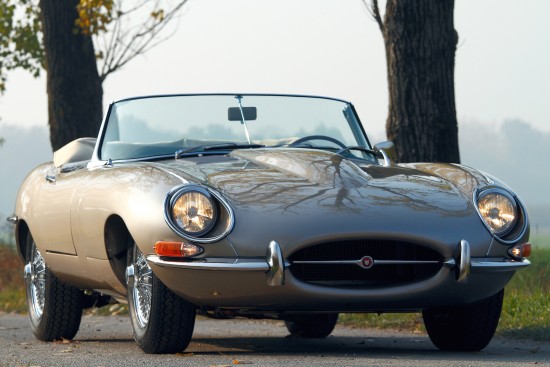
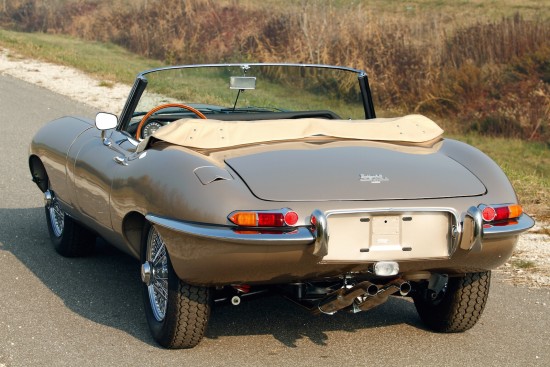
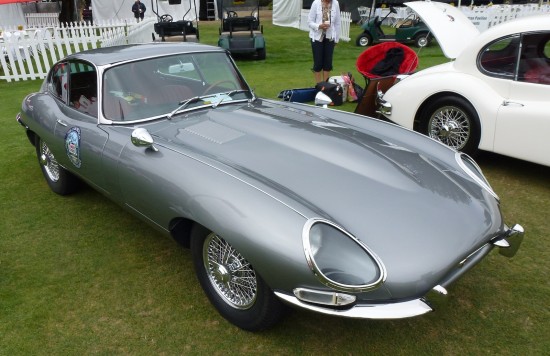
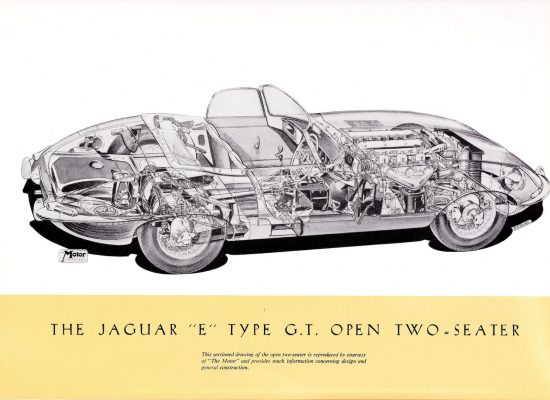
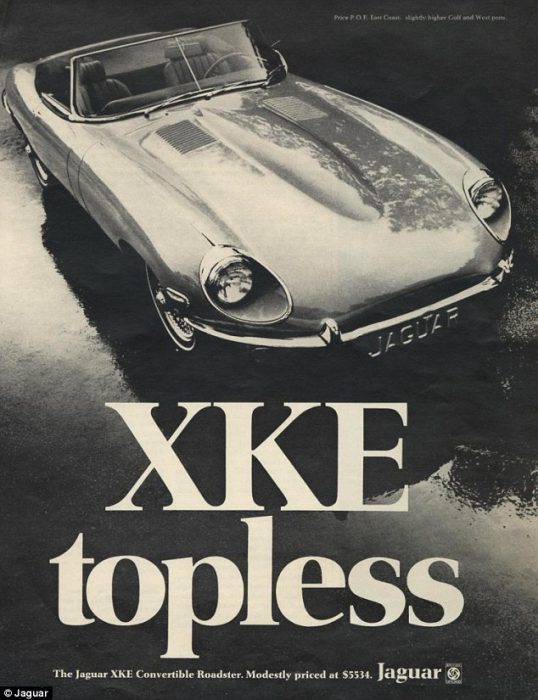
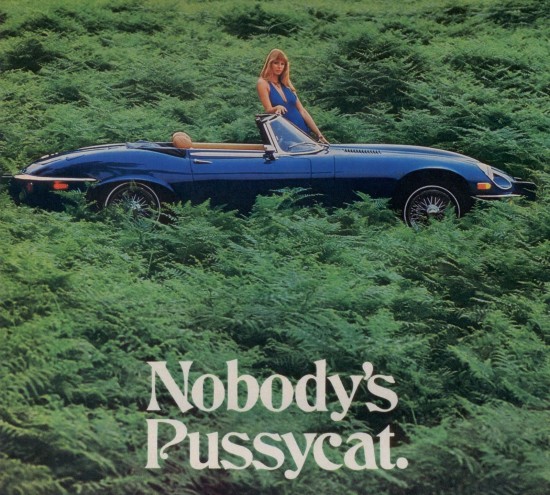
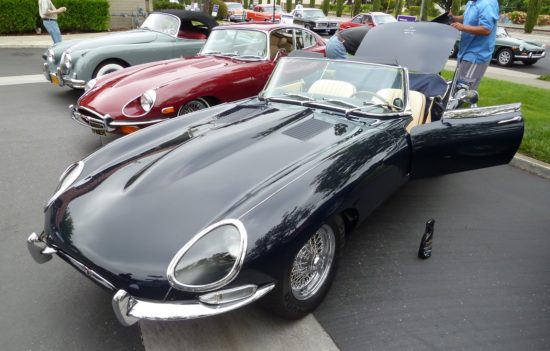
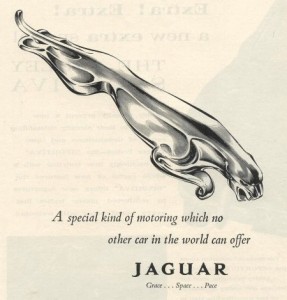
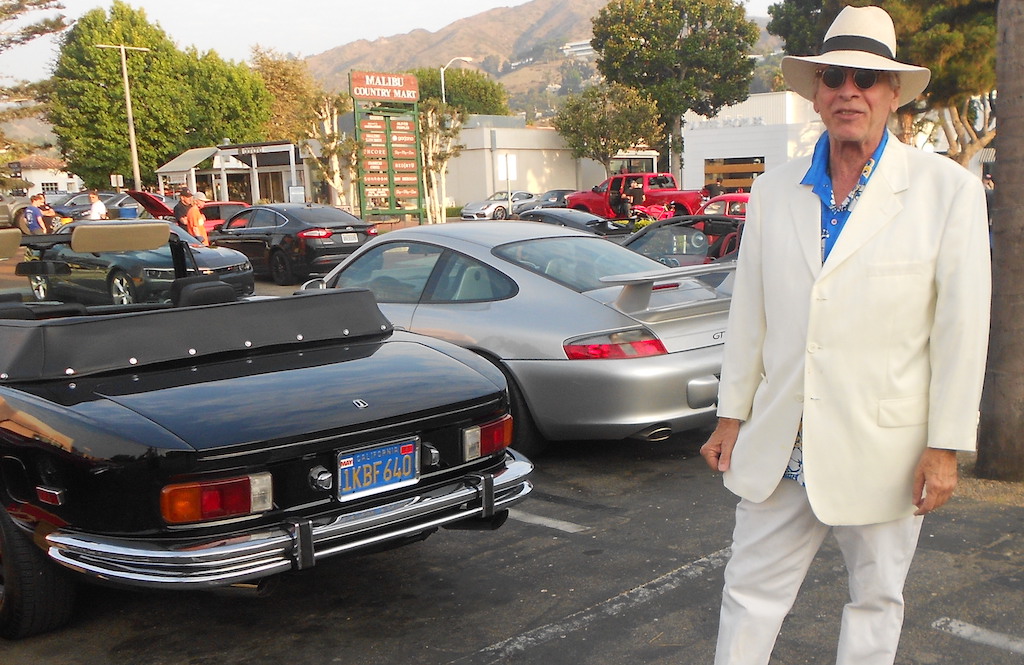
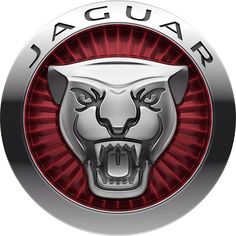
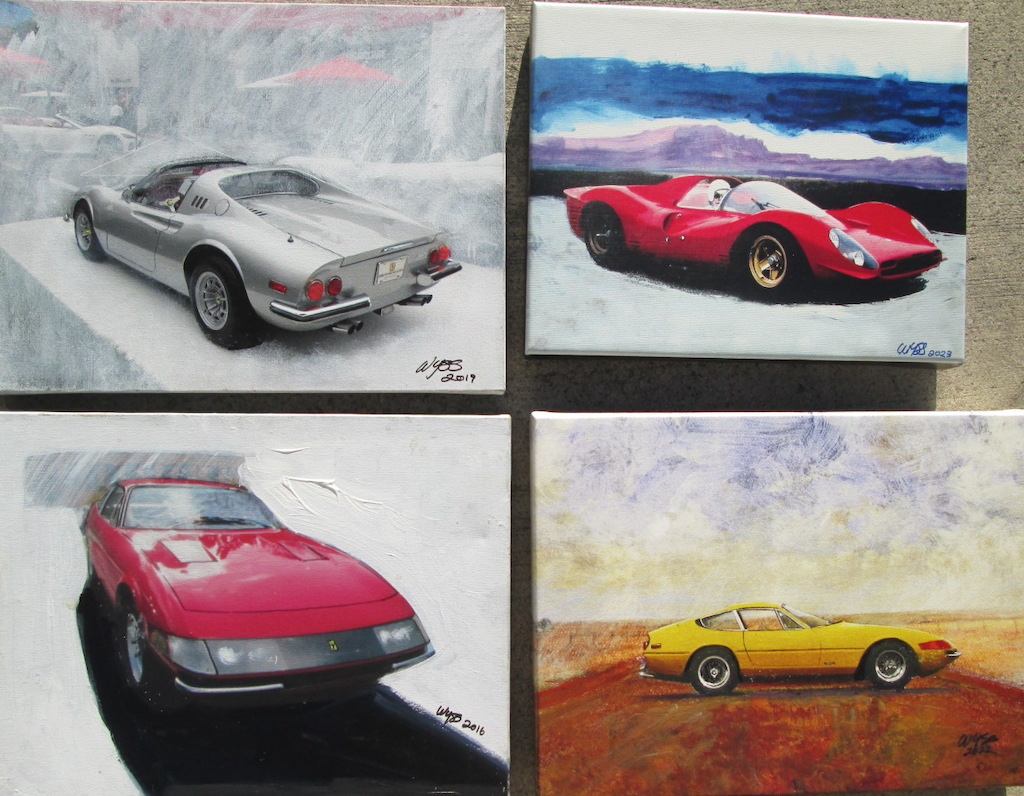

Wallace: I believe you should update the “Series” designations to what E Type owners and Jag have been saying for years:
Series One includes the 3.8 L engine and the Moss gearbox with non-synchro 1st; the introduction of of the 4.2 L engine and a fully synchronized gearbox, with negative “earth” and an alternator is still included in Series One. These 4.2 cars also had the new seat design with adjustable seat backs
Series 1 1/2 was for the 1968 model year and featured headlamps without the glass covers, a center IP with rocker switches instead of toggles, and “safety” window winders and interior door handles. And, as you mentioned, no “eared” knock on spinners and the twin Stromberg carbs in place of the triple HD8 SUs, and seat backs with head rests
Series 2 cars came out for 1969 and had modified “un-covered” headlamps and a new tail lamp set up under the rear bumper (this was a bolt-on assembly). The front bumper was also simplified
Series 3 cars were the V-12s in 1972, and were built on the longer 2+2 chassis, had fender flairs for wider wheels, revised frontal treatment with an actual grille, and tail lamps integrated into the rear bodywork. It also had a leather-covered steering wheel
There are times I miss the 3.8 E that I sold nearly 40 years ago. Then I think of replacing the starter and don’t miss it anymore!
Cut a temporary small hole in the transmission tunnel and R+R it. Worked for my 65.
I have a 1968 Series one and a half which has triple SU carburettors , so I don’t know when they changed to two Strombergs . I live in Australia , so maybe it was an United States of America thing !